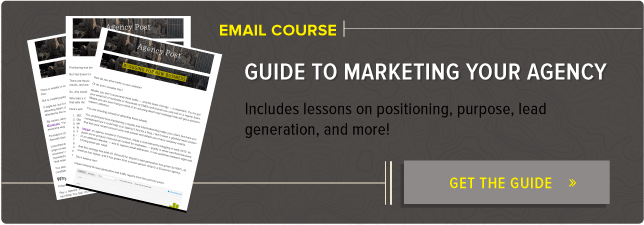
In a rapidly changing digital landscape, marketing agencies need to be ahead of the curve. Providing a diverse range of high-quality content is an integral part of a sustainable competitive advantage -- but agencies also need to be frugal and clever with where and how they invest their time, money and energy.
Although blogs are still very popular, audiences are somewhat limited in how they can consume them -- you can’t read a blog at the gym or while driving, for instance. With this in mind, podcasting is a great way for agencies to connect with their audience and personify the brand while simultaneously diversifying their content channels, thus allowing audiences to engage with content in their preferred manner.
This post details everything you need to know to start a podcast -- from the equipment and technical aspects to the promotion and distribution.
Why Start a Podcast?
There’s a plethora of research to back up my own personal belief in the power of podcasting. Edison Research's 2016 Infinite Dial study showed a significant year-over-year increase in podcast listenership, with monthly listenership increasing from 17% to 21%. Research in the UK and Europe has also shown an uptick in the popularity of podcasts, with the Winter 2016 Rajar Midas Audio Survey reporting 4.7 million podcast listeners.
While these statistics are promising, let’s be clear from the start: Podcasts don't typically open the floodgates in terms of leads. However, as a lead nurturing content channel, they’re incredibly powerful. Much like having an established blog with a good following, having an established podcast can help you to stand out as a thought leader in your industry -- which will then help you generate leads.
Podcasting is by no means a quick fix; you need to be willing to put time into building it up the same way you would a blog. But if you can dedicate the time and effort, it can be incredibly rewarding in terms of increased engagement with your existing customer base and also in elevating your agency's visibility and reputation.
How Agencies Can Start a Podcast
Equipment
Some people would have you believe that in order to podcast, you need to have a full recording studio setup, complete with expensive, difficult-to-use equipment -- but that’s not the case at all. You could start a podcast this very second just using your cell phone and a free SoundCloud account! It really is that simple, so don’t be deterred by overthinking things the technical side of things.
If you're going to be podcasting regularly, I would advise investing in a USB microphone. A Blue Yeti works perfectly fine and isn’t too expensive at approximately $130. If you visited the podcast booths at INBOUND 2016, you’ll have seen them first-hand. These and other USB microphones plug right into your computer without the need for a pre-amp to control/convert the voltage -- necessary to connect some of the higher-end microphones, like a Rode NT1A.
If you'll be conducting interviews for your podcast, the Zoom H1 portable recorder, featuring built-in unidirectional microphones, is a lightweight option to carry in your bag or your briefcase. It retails for approximately $100 -- not exactly breaking the bank.
Content
Now that you have your equipment ready to record, what should you talk about in your podcast? A while ago I came up with what I call the "C.A.S.T" content creation model, which stands for Content, Audience, Subject Matter, and Time.
Here's how it works: The Content should be relevant to your Audience; your Audience should be able to relate to the Subject Matter; the Subject Matter should be Timely (and preferably, Timeless). You know your customer persona well -- put yourself in their shoes, think about what they would be interested in, and you’ll soon have a list of topics to speak about. Better still, directly ask them what they’d like to hear!
Also, think about repurposing. Do you have a successful webinar that you could easily take the audio from? That can be a podcast episode. You could also turn it into a blog post and an ebook -- or vice versa. Scaling your content in this way maximizes the ROI you receive and helps to disseminate your most powerful messages through more than just one channel.
Recording
When you’re ready to hit record, there are a few things to consider.
If you don’t want any background noise, be sure that you research or maybe even reserve a quiet space to record in. On the other hand, if you would like ambient noise or a specific auditory "setting" for your podcast, like a café, check that it doesn’t over power the conversation.
One handy tip I often share for the recording process is taping your list of questions to the wall or table to avoid rustling paper in your hands. Also be aware of things like a clock ticking in the background -- if you need to edit the audio, these background sounds can easily get distorted, which is distracting for listeners.
Hosting
There are several well-known hosting options available to you, such as SoundCloud, Stitcher, Podomatic, Pandora, Libsyn, and iTunes. My personal top two are SoundCloud and iTunes.
SoundCloud is very straightforward to navigate and to review statistics in. It takes just seconds to start a free account, where you’ll have three hours of upload time to work with -- a good amount of time to test and then consider spending money on a paid hosting platform.
For example, let's say you start a marketing tips podcast, and each episode clocks in at 10 minutes. Your free SoundCloud account will allow for 18 episodes; by which point, you should have an idea of how things are going, and can make an informed decision of whether or not to pay for the platform of your choice. Even if you decide to move away from regular podcasting, you’ll still have an audio library of content you can share with customers and potential leads for months to come.
Hosting on Libsyn is an affordable option with some good benefits to it -- particularly if you use their 'On Publish' option, which will auto-post your podcast to various channels of your choice. This saves you the effort of having to login to various platforms each time you want to release an episode. Again, this isn't really necessary when you're just testing the waters and starting out, but it's worth researching if you think you'd like to keep your podcast going long-term.
Editing
When it comes to editing -- like learning anything new -- it takes practice. Starting with a simple-to-use software like Audacity will enable you to see how the process works, but don't leave it until the last minute -- record a few minutes of test audio and edit it in Audacity to learn how it works before you're on a time-crunch with your podcast.
When you've built up some confidence, move on to using Adobe Audition, where you'll have a much broader selection of options for editing, and you'll be able to ensure a professional standard. There are several YouTube tutorials for both of those editing platforms, which are really helpful. Recording in WAV format is generally best, as it's a larger file size that allows you to retain the quality of the audio throughout the editing process.
Promotion
Promoting a podcast is similar to how you might promote a webinar or video channel. Your weekly or monthly email newsletters provide a perfect opportunity to draw attention to your podcast. A persuasive CTA with an action verb is a great addition to your general company news email sends. A blog sidebar CTA for your podcast might also help drive traffic.
Another excellent way to promote your podcast is co-marketing. Think of successful YouTube creators who regularly have guest spots on each others' videos as a form of cross-promotion. We can apply that same theory to podcast promotion by partnering up with an already established podcast and co-promoting each other’s work. Working with someone who has already been running a successful podcast will also allow you the opportunity to learn more about how to get your own podcast off the ground.
Measuring Success
Measuring the success of your podcast depends, as always, on your definition of success according to your own goals.
Podcasters typically measure success by the engagement relative to the reach (how many listens we see in the podcast’s statistics vs. the number of people our content can potentially be heard by). Each platform/host will have their own ways of displaying statistics, but it’s important to remember that building an audience for a podcast takes time, so you’ll need to be patient and continue to promote.
What Are You Waiting For?
The most important thing about getting started with a podcast? Actually going ahead and hitting "record." Start with your cell phone and a free SoundCloud account and see how it goes. If it doesn’t pan out, there’s very little investment other than time -- and if it goes really well, you can take the next steps to make it a strong content channel for your business.
If you take away anything from this blog post, I hope it’s that setting up a podcast is something that you can do easily. So what are you waiting for? Go and hit record!

No comments:
Post a Comment